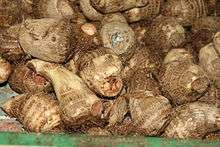Eddoe
| Eddoe | |
|---|---|
 | |
| Scientific classification | |
| Kingdom: | Plantae |
| (unranked): | Angiosperms |
| (unranked): | Monocots |
| Order: | Alismatales |
| Family: | Araceae |
| Genus: | Colocasia |
| Species: | C. antiquorum |
| Binomial name | |
| Colocasia antiquorum Schott | |
| Synonyms[1] | |
| |
Eddoe or Eddo is a tropical vegetable often considered identifiable as the species Colocasia antiquorum,[2] closely related to taro (dasheen, Colocasia esculenta), which is primarily used for its thickened stems (corms).[3][4] It has smaller corms than taro, and in all but the best cultivars there is an acrid taste that requires careful cooking.[3] The young leaves can also be cooked and eaten, but (unlike taro) they have a somewhat acrid taste.[3]
Eddoes appear to have been developed as a crop in China and Japan and introduced from there to the West Indies where they are sometimes called "Chinese eddoes".[3] They grow best in rich loam soil with good drainage, but they can be grown in poorer soil, in drier climates, and in cooler temperatures than taro.[3]
Eddoes are also called malangas in Spanish-speaking areas, but that name is also used for other plants of the Araceae family, including tannia (Xanthosoma spp.).[3] Eddoe is known as arvi or arbi in Urdu and Hindi and kochur mukhi in Bengali in South Asia, chembb or Chembu in Malayalam and Pindalu in Nepali language.
Eddoes make part of the generic classification cará or inhame of the Portuguese language which, beside taro, also includes root vegetables of the genera Alocasia and Dioscorea. They are the most commonly eaten inhames/carás in the states of São Paulo, Rio de Janeiro and Espírito Santo, as well as surrounding regions of all.[5] They are also fairly common in Northeastern Brazil, where they might be called batata (literally "potato"), but less so than true yams of the genus Colocasia. According to Brazilian folk knowledge, the eddoes most appropriate to be cooked are those that are more deeply pink, or at least pinkish lavender, in the area where the leaves were cut.
Taxonomy
Linnaeus originally described two species which are now known as Colocasia esculenta and Colocasia antiquorum of the cultivated plants that are known by many names including eddoes, dasheen, taro, but many later botanists consider them all to be members of a single, very variable species, the correct name for which is Colocasia esculenta.[6][7]
References
- ↑ "The Plant List: A Working List of All Plant Species". Retrieved 15 February 2015.
- ↑ Utilisation des aliments tropicaux: racines et tubercules, FAO, Rome, 1990, p. 35. ISBN 92-5-202775-0, google book.
- 1 2 3 4 5 6 Purseglove, J.W. 1972. Tropical crops. Monocotyledons. Longman & John Wiley, Harlow and New York.
- ↑ R. Tumuhimbise et al (2009) Growth and development of wetland-grown taro under different plant populations and seedbed types in Uganda. African Crop Science Journal, Vol. 17, No. 1, 2009, pp. 49-60
- ↑ Eatable: cará and inhame, column Nhac of the Paladar journal (Portuguese)
- ↑ Albert F. Hill (1939), "The Nomenclature of the Taro and its Varieties", Botanical Museum Leaflets, Harvard University, 7 (7): 113–118
- ↑ USDA GRIN Taxonomy, retrieved 24 April 2015
